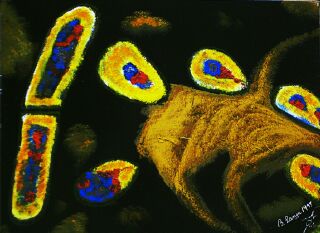|
by Vanessa Raney, all rights reserved.
I took Biology as an undergraduate in Summer 2003. For one assignment, we created
WebCT Homepages addressing different bacterial-based diseases; mine was on tuberculosis. Although my original
presentation was much nicer than what you have here, I remain very pleased with my work. Please let me know your thoughts;
e-mail me. Thanks!

|
| Image courtesy of http://www.masterpieces.ws/Paleface.htm. |
Meet the Parasite
You risk tuberculosis (TB), an airborne agent, when an infected person opens his or her mouth. What you
get are the microscopic Mycobacterium tuberculosis (M. tb), or tubercle bacillus, that stick to
the alveoli, or air sacs, in your lungs. (1) However, the bacteria can remain latent for
years before symptoms appear, during which time you can't infect others. (1)(2) If not treated,
the white blood cells called macrophages (1), or "alveolar macrophages (specialized cells
that destroy bacteria and viruses)" (3), may be overwhelmed, thus activating the contagion TB.
(1)(3)
'Place in This World' (4)
You might think because of the way TB affects your body that it could be a virus. In fact, if you recognized
a relationship between TB and the AIDS virus (5), you're not completely off track. Except that
M. tb is classified as bacteria, and belongs to Kingdom Bacteria. (1). The tubercle
bacillus, similar to other types of single-celled organisms with free floating DNA, are also prokaryotic (6),
not to mention parasitic (7).
Symptoms of the Adolescent
"TB usually kills a person by gradually eating holes in the lung." (8) If you
have TB, however, you may or may not be aware of the symptoms once the disease is active. Like soldiers, the M. tb
scope out the battlefield and engage the macrophages, their natural enemy, in warfare. As part of their escape, though
dogged by the macrophages, the terbucle bacillus take the blood expressway, "or lymphatic system" (1), to other parts of the body, among them the kidneys, bones (1)(9), skin,
reproductive and urinary system (1), spine and brain (9).
So the severity of your symptoms depends on where the bacteria set up their forts. Generally, you can expect
to experience weight loss, fevers, night sweats, loss of appetite and persistent coughing. (1)(2)(10)(11)
As the TB comes of age, you might also notice bleeding, back pain and deformities, again depending on the location of the
bacteria. The more progressive TB actually results from the growth of the adolescent M. tb, which form granulomas,
or garrisons, around the forts. Yet the lungs, integral to the tubercle bacillus' formative development, remain the
focal point. (1). "In more than 65%, TB is located in lung and in that case respiratory symptoms
occur (cough, phlegm, and others) with abnormalities in X-ray image; the diagnosis is based not on X-ray but on the identification
of the TB bacilli in the sputum of the patient." (10)
On a personal note, I've known one person who had TB. It surprised him because at the time he collapsed
and was taken to the hospital, he thought it was a heart attack. Describing his (advance) symptoms, he said he felt shooting
pains across his chest, tightening of his arms and nausea. (12)
Taking Control
Like AIDS, TB's transmitted by direct contact. The difference is that while AIDS needs your blood to get
inside you, TB needs only the air around you. And it doesn't take much for an infected person to infect you; contact is made
through talking, singing, laughing, coughing, sneezing, etc. - anything with an open mouth. (1)(2)(3)(10)
While it's not clear how long the M. tb can stay in the air, the remains of a sneeze may take thirty minutes to dissolve.
So it's possible for you to get infected even without direct contact (13), except that "TB bacillus
is very sensitive to sunlight and can wiped out by natural or artificial ventilation" (10).
However, one important distinction between AIDS and TB is that TB has a known cure, which works in ninety
percent of patients. However, your odds decrease by thirty percent if you ignore the warning signs for TB. To stand guard
against receiving or transmitting TB, make sure you have "adequate ventilation," show etiquette when you sneeze or cough,
and follow your doctor's recommendations. (1). "In the majority of countries, infected persons
are not treated ; however, in very few countries, those with very low TB prevalence (ei. USA), chemoprophylaxis is carried
out in case of TB infection in order to sustain the TB elimination process in the communities." (10)
Some of the drugs and vaccines used to prevent TB or to treat advanced TB include NIH (1), BCG*
(1)(2), or a combination of Isoniazid, Rifampin, Pyrazinamide, and Ethambutol or streptomycin (11). Early detection, though, is key.
* "First used in 1921, BCG consists of live, attenuated Mycobacterium bovis, a close relative of
M. tuberculosis." (14)
Did You Know?
So you want to know the risk factors for TB? As of the year 2000, your chances of getting TB increased if,
according to the CDC, you had AIDS; were male; lived in or visited a country like Asia, Africa or Latin America; belonged
to a minority group; ranged in age between twenty-five and forty-four (same as for AIDS); could be counted as "foreign-born"
in the US; resided in California, Florida, Georgia, Illinois, New Jersey, New York, or Texas. However, rates of TB in the
US were in steady decline between 1992 and 2000. (15) By 2003, WHO's list of "high-burden countries"
included Afghanistan, Bangladesh, Brazil, Cambodia, China, Democratic Republic of Congo, Ethiopia, India, Indonesia, Kenya,
Mozambique, Myanmar, Nigeria, Pakistan, Philippines, Russian Federation, South Africa, United Republic of Tanzania, Thailand,
Uganda, Viet Nam, and Zimbabwe. (16). WHO also claimed that "TB is the single biggest infection
killer of women," especially "of young women." (17). So remember, male or female, you're still
at risk.
Now, while you might be thinking that TB only affects humans, there's actually another strain of TB called
Bovine TB. Although Bovine TB is mostly found in cows, we humans can also get it. The bacteria responsible for Bovine TB is
Mycobacterium bovis, which is related to the bacilli M. tb and M. avium. (18)(19)(20)
"No other TB organism has as great a host range as bovine TB, which can infect all warmblooded animals. M. avium
can affect all species of birds, as well as hogs and cattle. M. tuberculosis primarily affects humans but can also
be transmitted to hogs, cattle, and dogs." (20) Because these TB bacilli belong to "the Mycobacterium
complex" (18), they are very similar to the way they are transmitted (18)(19)(20)
and in regard to the symptoms that develop during advanced stages (18)(19). However, while
M. tb's primarily located in the lungs, with Bovine TB, "The primary site of infection is the lymph nodes, but spread
to other organs such as the lungs will occur as the disease progresses." (18) It certainly explains
why Bovine TB in animals like cows sometimes fails to get diagnosed until after post mortem. (18)(19)
Another difference between M. tb and Bovine TB is that Bovine TB can also be trasmitted by "the drinking of unpasteurized
milk from an infected cow and the sharing of common water or feed sources." (18) Unlike us humans,
though, no treatment exists for the TB infected livestock. Therefore, instead of getting cured, these non-human animals are
murdered. (18)(19)(20)
As for interesting tidbits, did you know that M. tb can be traced back to the Egyptians? (21)(22) It was also known by different names throughout the centuries: "(p)hthisis, consumption, the
English Disease, White Plague, decay." (23) Yet TB didn't show favoritism. Those who died included
some of the greats in literature, among them John Keats, Frederick Chopin, Anton Chekov, Robert Louis Stevenson, Emily Bronte,
Franz Kafka, George Orwell, and D.H. Lawrence. As for the different attempts to remedy TB, the Romans suggested "bathing in
human urine, eating wolf livers, and drinking elephant blood." (21) Many of the scientists who
helped to advance our understanding of TB included Hippocrates, Girolamo Francastoro, Frans de le Boe, Sylvius, Manget, Benjamin
Marten, Richard Morton, Leopold Auenbrugger, Rene-Theophile-Hyacinthe Laennec, Hermann Brehmer, Jean-Antoine Villemin, Robert
Koch, Wilhem Konrad von Rontgen, Carlo Fortanini, Clemens von Pirquet, Calmette (with Guerin), and Selman A. Wakesman (with
Schatz and Bugie). (24) Yet John Bunyan's the one who gave us the adage for TB, still widely known
as "the Captain of all the men of death." Ironically, "M. tb today causes more deaths than any other single infection
agent." (23) The difference is, today you can be cured of TB.
Endnotes
Note: This project was completed in 2003; thus, some of the links below may no longer work.
(5) The modes of transmission for AIDS and TB are very similar, as are the fears associated
with them. see Taking Control. section.
(6) see Chapter One - Part III Course Notes, Unit 1.
(7) A parasite is basically an organism that attaches onto another organism to feed.
(8) 10 facts about tuberculosis. (Source: TB Advocacy, A Practical Guide 1999, WHO Global
Tuberculosis Programme WHO Fact Sheet N 104, August 2002). International Union Against Tuberculosis and Lung Disease
(IUATLD); see http://www.iuatld.org/pdflen/facts - tuberculosis.pdf. Accessed 8 July 2003.
(10) E-mail from Dr Salah-Eddine Ottmani, Medical Officer, CDS / Stop TB / TBS, World Health
Organization (WHO), Geneva. Received 30 June 2003.
(12) This was part of a student presentation he gave, c.1999.
(13) Based on general knowledge.
(16) Country Information. (Source: "Global TB Control Report 2003.") WHO Global Tuberculosis
Programme, Tuberculosis Strategy & Operations, Monitoring & Evaluations; see http://www.who.int/gtb/Country_info/index.htm. Accessed 27 June 2003.
(17) 10 Tuberculosis facts about women. (Source: "10 facts about tuberculosis and women,"
TB Advocacy, A Practical Guide 1999, WHO Global Tuberculosis Programme.) IUATLD; see http://www.iuatld.org/pdf/en/facts_women.pdf. Accessed 8 July 2003.
|


